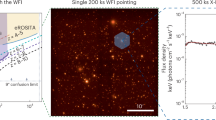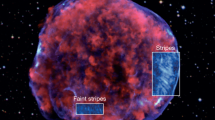
Overview
- Reviews astrophysical discoveries by over-20-year X-ray grating data and latest microcalorimeter data
- Covers instrumentation, data reduction/analysis, and science
- Offers tutorials for data reduction of RGS/XMM-Newton, LETG/Chandra, HETG/ Chandra, and SXT/Hitomi
Part of the book series: Springer Series in Astrophysics and Cosmology (SSAC)
Access this book
Tax calculation will be finalised at checkout
Other ways to access
About this book
Similar content being viewed by others
Keywords
Table of contents (14 chapters)
-
Front Matter
-
Instrumentation and Data Analysis
-
Front Matter
-
-
Science
-
Front Matter
-
Editors and Affiliations
About the editors
Cosimo Bambi is currently Xie Xide Junior Chair Professor at the Department of Physics at Fudan University. He received the Laurea degree from Florence University in 2003 and the PhD degree from Ferrara University in 2007. He worked as a postdoctoral research scholar at Wayne State University, IPMU/The University of Tokyo, and LMU Munich. He joined Fudan University at the end of 2012 under the 1000 Young Talents Program. His main research interests focus on theoretical and observational studies on black holes. He has published about 200 papers on high impact factor refereed journals as first or corresponding author and has over 10,000 citations. He has published several books with Springer, either as author and editor. He has received a number of awards, including the Magnolia Gold Award in 2022 and the Magnolia Silver Award in 2018 from the Municipality of Shanghai, the International Excellent Young Scientists Award from the National Natural Science Foundation ofChina in 2022, and the Xu Guangqi Prize from the Embassy of Italy in Beijing in 2018.
Jiachen Jiang:
Jiachen Jiang received his bachelor's degree in physics from Fudan University in 2016 and his PhD in Astronomy from Cambridge University in 2020. He worked as a postdoctoral scholar at Tsinghua University and is currently a Leverhulme Trust/Isaac Newton Trust Fellow at the Institute of Astronomy, Cambridge University. His research focuses on multi-wavelength observations of accreting black holes, including stellar-mass black holes in binary systems and supermassive black holes in the centre of galaxies.
Accessibility Information
Bibliographic Information
Book Title: High-Resolution X-ray Spectroscopy
Book Subtitle: Instrumentation, Data Analysis, and Science
Editors: Cosimo Bambi, Jiachen Jiang
Series Title: Springer Series in Astrophysics and Cosmology
DOI: https://doi.org/10.1007/978-981-99-4409-5
Publisher: Springer Singapore
eBook Packages: Physics and Astronomy, Physics and Astronomy (R0)
Copyright Information: The Editor(s) (if applicable) and The Author(s), under exclusive license to Springer Nature Singapore Pte Ltd. 2023
Hardcover ISBN: 978-981-99-4408-8Published: 02 September 2023
Softcover ISBN: 978-981-99-4411-8Due: 15 September 2024
eBook ISBN: 978-981-99-4409-5Published: 01 September 2023
Series ISSN: 2731-734X
Series E-ISSN: 2731-7358
Edition Number: 1
Number of Pages: VIII, 425
Number of Illustrations: 24 b/w illustrations, 139 illustrations in colour
Topics: Spectroscopy and Microscopy, Astronomy, Observations and Techniques, Measurement Science and Instrumentation, Astrophysics and Astroparticles



